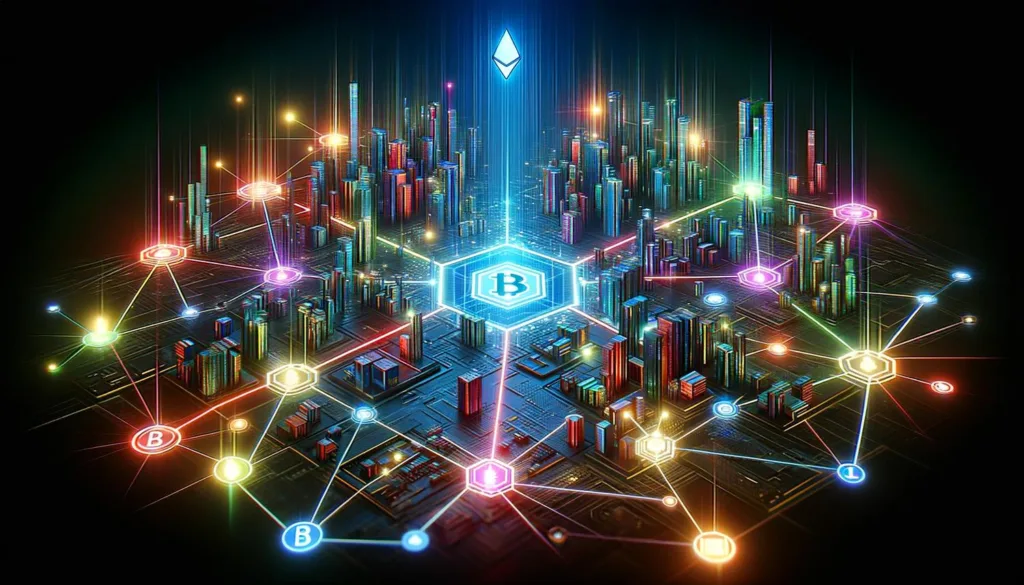In the ever-evolving landscape of finance, a new horizon has emerged, one that promises to redefine our understanding of money, investments, and banking. This horizon is Decentralized Finance, commonly known as DeFi. For someone who has spent over two decades weaving through the intricate labyrinths of computer programming, the emergence of DeFi felt like a parallel universe where the rules of finance are rewritten in the language of code. It’s a realm where traditional financial intermediaries are replaced by smart contracts and blockchain technology.
DeFi Unveiled: The Basics
DeFi, at its core, is an ecosystem of financial applications built on blockchain networks. Unlike traditional banking, which relies on central authorities and intermediaries (think banks and financial institutions), DeFi operates on a decentralized, peer-to-peer model. It’s like comparing a tightly controlled, walled garden to a vast, open meadow.
The Underlying Technology: Blockchain
To understand DeFi, one must first grasp the basics of blockchain technology. At its simplest, a blockchain is a distributed ledger that records transactions across multiple computers in a way that ensures security and transparency. Imagine a ledger that’s not just in one bank’s vault but replicated in thousands of copies across the world, visible to everyone but tamper-proof.
Smart Contracts: The Building Blocks
The real game-changer in DeFi are ‘smart contracts’. These are self-executing contracts with the terms of the agreement directly written into lines of code. In my programming journey, the logic and structure of smart contracts felt familiar yet revolutionary. They automate processes and execute transactions without human intervention, much like a program running its course once certain conditions are met.
The DeFi Ecosystem: More Than Just Currencies
While cryptocurrencies like Bitcoin and Ethereum are often the most talked about, DeFi extends far beyond just digital currencies. It encompasses a wide range of financial services – from lending and borrowing platforms to stablecoins, tokenized assets, and even decentralized insurance. This ecosystem is rapidly growing, challenging traditional financial models with its accessibility, efficiency, and transparency.
In the next section, we’ll dive deeper into how DeFi is different from traditional banking, and the profound implications these differences have on the future of finance. As someone who’s navigated the complex algorithms and intricate codes of software programming, I find the logic of DeFi both familiar and fascinating – a testament to the transformative power of technology in the financial domain.
The Paradigm Shift: DeFi vs. Traditional Banking
Venturing into the realm of Decentralized Finance (DeFi) from a background steeped in traditional banking and programming is akin to stepping into a new dimension where familiar rules are reimagined. This section will explore how DeFi contrasts with traditional banking and the implications of this evolving financial landscape.
Breaking Down the Walls: Decentralization in Finance
- Intermediary-Free Transactions: In traditional banking, transactions pass through multiple intermediaries – from banks to clearinghouses. DeFi, on the other hand, operates on a peer-to-peer basis, facilitated by blockchain technology. It’s like moving from a world where every financial move is orchestrated by a central authority to one where individuals transact directly with each other, mediated by smart contracts.
- Accessibility and Inclusivity: Traditional banking systems are often criticized for their exclusivity and barriers to entry. DeFi democratizes finance, offering access to financial services to anyone with an internet connection. It’s a significant leap, particularly for unbanked populations worldwide. In my coding days, the push towards open-source platforms resonated with a similar ethos – breaking down barriers to access and participation.
- Transparency and Security: The blockchain’s transparency ensures that all transactions within DeFi platforms are visible and traceable. While this might seem like a privacy trade-off, it actually adds layers of security and trust. In coding, a similar parallel would be open-source projects, where the transparency of code leads to community-driven security enhancements.
The Role of Stablecoins and Liquidity
Stablecoins, like Tether, play a critical role in the DeFi ecosystem, offering a bridge between the volatile world of cryptocurrencies and the stability of fiat currencies. They are to DeFi what a regulated currency is to traditional banking but without the central control. Furthermore, liquidity in DeFi comes from the users themselves, through mechanisms like liquidity pools, unlike traditional banking where liquidity is often dependent on central banks and large institutional deposits.
Yield Farming: The New Investment Frontier
DeFi has introduced concepts like yield farming and liquidity mining, where users can earn returns by lending their assets or providing liquidity. This is a stark contrast to traditional interest-earning accounts or investment portfolios in conventional banking. It’s an innovative, albeit riskier, approach to earning investment returns, reminiscent of early high-risk, high-reward venture investments in the tech world.
Navigating Risks and Regulations
With innovation comes new challenges. DeFi, for all its advantages, also brings risks like smart contract vulnerabilities and regulatory uncertainty. The lack of a central governing body means users must navigate these waters themselves, emphasizing the need for education and caution. It’s similar to the early days of internet privacy – a new territory with its own set of challenges and learning curves.
As we dig deeper into the DeFi universe, it becomes increasingly clear that we are standing at the cusp of a financial revolution. It’s a space where the principles of programming – logic, efficiency, and innovation – find a new expression in the world of finance. In the following sections, we’ll explore the potential impact of DeFi on the future of finance and how users, from seasoned investors to curious beginners, can navigate this new frontier.
Embracing DeFi: Opportunities and Challenges for Investors

The burgeoning world of Decentralized Finance (DeFi) offers a plethora of opportunities for investors, but it also comes with its own set of unique challenges. This section looks into what investors need to know to effectively engage with DeFi, drawing parallels from traditional investment strategies while highlighting the new possibilities and risks inherent in this digital financial landscape.
The Allure of DeFi for Investors
- High Yield Potential: DeFi platforms often offer higher interest rates for lending and staking compared to traditional banks. This potential for higher yields is incredibly appealing, but it’s important to understand the risks involved, much like venturing into high-risk stocks or venture capital investments.
- Innovative Investment Vehicles: DeFi opens doors to novel financial products and services that don’t have direct equivalents in traditional finance. From tokenized assets and derivatives to decentralized autonomous organizations (DAOs), these instruments allow for diversified and dynamic investment strategies.
- Greater Control and Autonomy: DeFi empowers investors with more direct control over their financial assets. Smart contracts automate transactions without the need for intermediaries, offering a level of efficiency and control akin to managing one’s own digital portfolio in real-time.
Navigating the Risks and Complexities
- Volatility and Instability: The DeFi market is known for its volatility. Rapid fluctuations can lead to significant gains, but also substantial losses. As in any investment, diversification and understanding one’s risk tolerance are key.
- Technical Barriers and Complexity: DeFi can be technically complex, requiring a solid understanding of blockchain technology and digital wallets. For those more accustomed to traditional banking interfaces, the learning curve can be steep.
- Regulatory Uncertainty: The regulatory landscape for DeFi is still evolving. This lack of clarity can be a double-edged sword – offering freedom from traditional compliance, but also less protection for investors.
- Smart Contract Risks: The code behind DeFi services is not infallible. Bugs or vulnerabilities in smart contracts can lead to financial losses, underscoring the importance of due diligence and understanding the technical underpinnings.
DeFi Investment Strategies
- Start Small and Learn: Begin with smaller investments to understand the DeFi ecosystem. Use this phase as a learning experience to understand different platforms and tools.
- Stay Informed: The DeFi space is rapidly evolving. Staying informed about new developments, platforms, and tools is crucial for successful investing.
- Use Trusted Platforms: Engage with well-established and audited DeFi platforms. Look for platforms with a strong track record and transparent practices.
- Consider Professional Advice: Given the complexities, consulting with a financial advisor who understands both traditional finance and DeFi can provide valuable insights.
In the next section, we will explore the potential future of DeFi and its impact on the broader financial landscape, considering how this innovative space might evolve and integrate with traditional finance. The journey through DeFi is not just about embracing new financial tools but also about understanding a movement that could redefine our relationship with money, investment, and economic freedom.
The Future of DeFi: Integration and Evolution in Finance

As we stand at the forefront of the DeFi revolution, it’s essential to look ahead and ponder the potential trajectory of this burgeoning sector. Will DeFi seamlessly integrate into the tapestry of traditional finance, or will it carve out an entirely distinct path? This final section explores the prospective future of DeFi, its potential impact on the global financial system, and what it means for individual investors and the economy as a whole.
The Convergence of Traditional and Decentralized Finance
- Hybrid Financial Models: We may witness the emergence of hybrid models where DeFi and traditional banking coexist and complement each other. Banks might adopt blockchain technology to improve their services, while DeFi platforms could incorporate certain regulatory standards to gain broader acceptance.
- Increased Institutional Involvement: As DeFi matures, more institutional investors and financial entities are likely to enter the space. This involvement could bring about more stability and inject significant capital, but it could also lead to increased regulation.
- Mainstream Adoption and Accessibility: With ongoing developments in user interfaces and regulatory frameworks, DeFi is poised to become more accessible to the general public, potentially becoming as commonplace as using a traditional bank account.
Challenges and Opportunities Ahead
- Regulatory Frameworks: The development of comprehensive regulatory policies is crucial. Effective regulation could enhance investor protection without stifling innovation, fostering trust and stability in the DeFi ecosystem.
- Technological Advancements: Continued advancements in blockchain and smart contract technologies will be pivotal in addressing current limitations, enhancing security, scalability, and interoperability among platforms.
- Financial Inclusion: DeFi has the potential to democratize access to financial services, offering unbanked or underbanked populations a gateway to economic participation and empowerment.
Embracing a Financial Renaissance

Decentralized Finance marks a significant chapter in the evolution of the financial sector, one that is redefining our understanding of monetary transactions, investments, and economic autonomy. For enthusiasts and skeptics alike, one thing is clear: DeFi is not just a fleeting trend; it is a testament to the transformative power of technology in finance.
As we navigate this new era, the fusion of traditional financial wisdom with the innovative spirit of DeFi could lead us toward a more inclusive, efficient, and transparent financial future. For investors, staying informed, adaptable, and prudent will be key to navigating this dynamic landscape.
In essence, DeFi presents us with more than just an alternative financial system; it offers a glimpse into a future where finance is more democratic, accessible, and aligned with the digital age. Whether you are a seasoned investor, a curious observer, or a tech enthusiast, the journey through the world of DeFi is bound to be an enlightening one, full of challenges, opportunities, and the potential for profound economic change.



1 thought on “Decentralized Finance: A Beginner’s Guide”